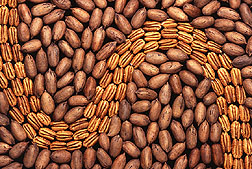
New bacterial extracts found by Agricultural Research Service
scientists may offer safe and effective alternatives to chemical fungicides
commonly used by peach and pecan growers. |
|

Click the images for more information about
them.
|
|

|
New Method May Thwart Pecan and Peach Diseases
By Sharon Durham
June 12 , 2008
Natural bacterial extracts may offer some assistance to peach and
pecan growers in treating fungal diseases such as brown rot in peaches and
pecan scab. Agricultural Research Service (ARS) scientists in Byron, Ga., are using
these substances as a safe and effective alternative to chemical fungicides.
ARS entomologist
David
Shapiro-Ilan and plant pathologist
Charles
Reilly at the
Southeastern
Fruit and Tree Nut Research Laboratory in Byron developed these natural
pesticides to control pecan and peach diseases. Although bacterial methods for
controlling fungi are not new, the ARS bacterial compounds have never been used
to control disease in these two commodities.
In 2006, the United States produced just over an estimated one million
tons of peaches and 100,500 tons of pecans. Various diseases result in annual
losses of more than $3.5 million for peach growers and $13 million for the
pecan industry.
In these studies, Shapiro-Ilan and Reilly used compounds obtained from
two genera of bacteria, Xenorhabdus and Photorhabdus. They
were found to be effective against common pecan and peach disease organisms
that cause significant damage. The two scientists tested compounds from a
variety of bacterial strains and species to determine which would be most
potent.
The results indicated that X. bovienii and P.
luminescens (VS) bacterial compounds generally exhibited the greatest
suppression of plant pathogens. Applying 6- to 12- percent dilutions of the
bacterial compounds achieved 90 to 100 percent suppression of Phytophthora
cactorum lesions on pecan leaves. P. cactorum can cause root,
collar and crown rots, as well as foliar and fruit infections.
The researchers also used bacterial compound treatments on pecan
shoots to control pecan scab disease caused by Fusicladosporium
effusum. The treatments reduced spore formation of F. effusum to
levels similar to those by chemical fungicides.
Applications for patents on these treatments have been submitted, and
partners are being sought to develop the bacterial metabolites for commercial
use.
ARS is a scientific research agency of the
U.S. Department of Agriculture.